45 Hybrid Phrase-Level Forms
John Peterson
Key Takeaways
- A hybrid form combines the beginning of one archetype with the ending from another.
- Possible beginnings are antecedents, presentations, or compound basic ideas.
- Possible endings are consequents, continuations, or cadential endings.
- Although any beginning could be combined with any ending, some pairings are more common than others (see Example 7).
What’s a hybrid form?
In The Phrase, Archetypes and Unique Forms, we looked at two phrase-level formal archetypes: the sentence and the period.
We found that these forms divide into two parts. A sentence divides into two subphrases: a presentation and a continuation. A period divides into two phrases: an antecedent and a consequent.
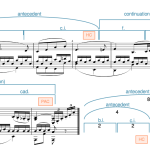
A hybrid form occurs when the beginning of one archetype is paired with the ending from another archetype. In Example 1, an antecedent is followed by a continuation.
- How do we know the first part is an antecedent rather than a presentation?
- It ends with a weaker cadence, whereas presentations don’t end with cadences.
- It has a basic idea followed by a contrasting idea, whereas presentations have a basic idea followed by a repetition of the basic idea.
- How do we know the second part is a continuation rather than a consequent?
- Rather than beginning as consequents do with a basic idea, it begins with fragmentation, which is characteristic of continuations.
- It begins with a feeling of instability created by the dominant that continues after the half cadence, rather than the stability that’s typical of a consequent’s beginning.
So far, we know two beginnings (presentation and antecedent) and two endings (continuation and consequent), but there’s actually one more possible beginning (compound basic idea) and one more possible ending (cadential). Below, we’ll outline these new beginnings and endings and provide ways to help distinguish between them.
Beginnings
New: The Compound Basic Idea (c.b.i.)
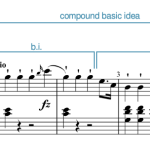
A compound basic idea (c.b.i.) is an antecedent without a cadence, as seen in Example 2.[1]
- How is Example 2 like an antecedent?
- It contains a basic idea followed by a contrasting idea.
- How is Example 2 different from an antecedent?
- It doesn’t end with a cadence. Notice how the bass sits on G across mm. 3–4: although the melody comes to a point of rest, the lack of harmonic motion in the bass evades the half cadence (HC) that might have appeared there.
Summary: The Three Beginning Types
The three beginnings that appear in hybrid phrase-level forms are antecedent, compound basic idea, and presentation. Example 3 provides a summary of the characteristics that differentiate each of these beginnings.
[table “8” not found /]
Example 3. Characteristics that differentiate beginnings.
Endings
New: Cadential (cad.)
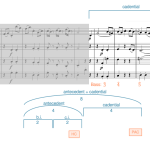
A cadential (cad.) ending harmonizes a particular bass pattern (demonstrated in Example 4).[2]
The core bass pattern is mi–fa–sol–do ![]() .[3] The common harmonization of each of these notes is:
.[3] The common harmonization of each of these notes is:
- mi
 : I6
: I6 - fa
 : ii6 or IV
: ii6 or IV - sol
 : V(7) (often elaborated with cadential
: V(7) (often elaborated with cadential  )
) - do
 : I
: I
This core mi–fa–sol–do ![]() bass line may be embellished. A common embellishment is to tonicize the dominant by adding fi before sol (
bass line may be embellished. A common embellishment is to tonicize the dominant by adding fi before sol (![]() , making the bass line mi–fa–fi–sol–do
, making the bass line mi–fa–fi–sol–do ![]() .
.
The clearest cadential endings are four measures long with one bass note per measure.
Summary: The Three Ending Types
The three endings that appear in hybrid phrase-level forms are consequent, continuation, and cadential. Example 5 provides a summary of the characteristics that differentiate each of these endings.
[table “9” not found /]
Example 5. Characteristics that differentiate endings.
Hybrid Possibilities and Examples
The three possible beginnings and three possible endings are shown in Example 6. While any beginning on the left could be paired with any ending on the right, Example 7 shows that there are some pairings that are more common than others.
Below, we provide examples for all hybrids in the “slightly less common” and “occasional” categories (Examples 8–12). We already provided examples of the period and sentence in The Phrase, Archetypes, and Unique Forms.
The examples we provide in this chapter are all eight-measure archetypes, but as we show in the next chapter, these forms can be any length.
[table “10” not found /]
Example 6. Possible beginnings and endings. Any beginning on the left can theoretically pair with any ending on the right.
[table “11” not found /]
Example 7. Pairings of beginnings and endings sorted by degree of commonality.
Listening to Phrase-level Forms
With so many possibilities, it might seem overwhelming to try to sort through the various possibilities. Example 13 offers a suggested listening strategy that can help determine what kind of beginning and ending you’re hearing.
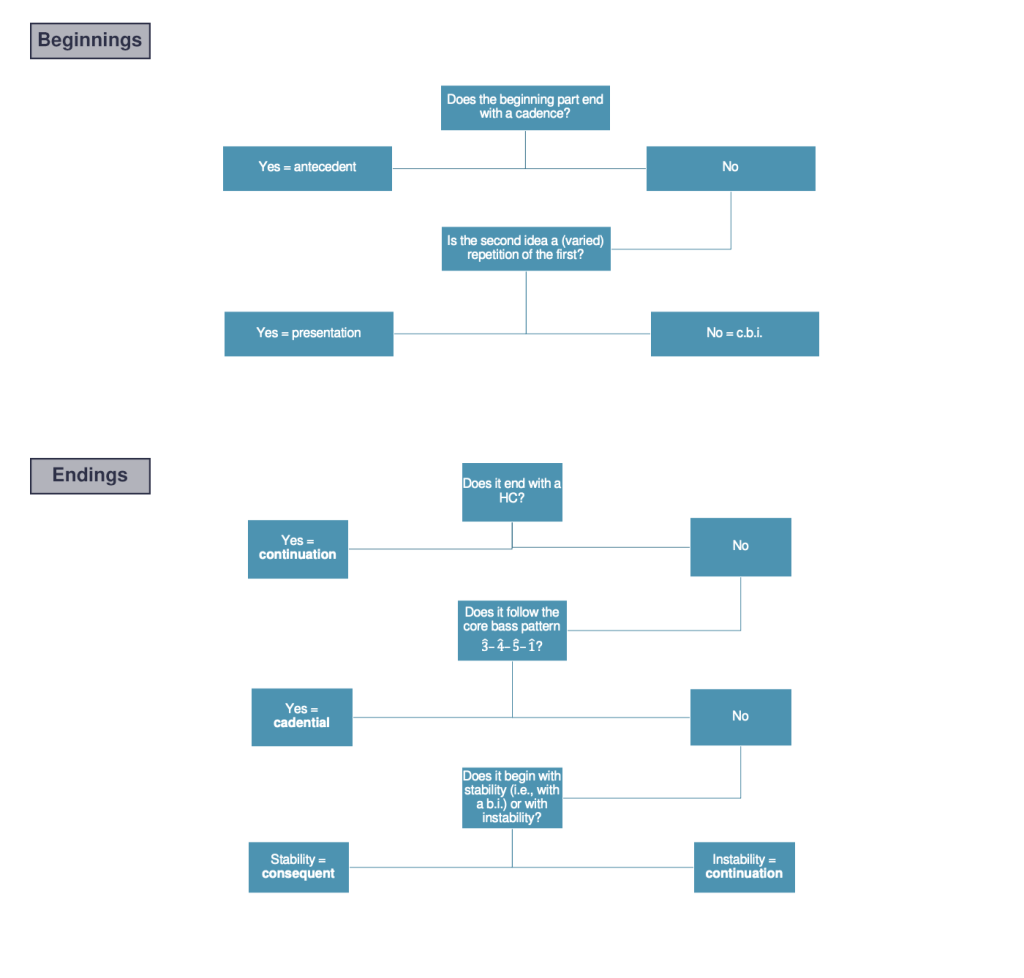
-
Caplin, William Earl. 2013. Analyzing Classical Form: An Approach for the Classroom. New York: Oxford University Press.
- Analyzing hybrid forms (.pdf, .docx). Provides excerpts and asks students to indicate which term best describes the first and second half of each. Optional harmonic analysis included. Worksheet playlist
- Analyzing forms with multiple possibilities (.pdf, .docx). Asks students to identify preferred and plausible alternative interpretations for several excerpts. Also includes band music. Worksheet playlist
- Composing phrase-level forms (.pdf, .docx). Asks students to compose a phrase-level form given a description. Provides a basic idea bank to give students a start.
- What is "compound" about the compound basic idea? It often functions as the basic idea of a large sentence, one that is sixteen measures in length, where the presentation is eight measures long and comprises two c.b.i. units. It's "compound" in the sense that these large basic ideas are themselves composed of two units: a b.i. and a c.i. ↵
- What is the difference between a cadential idea and cadential ending? The cadential idea comes at the end of a continuation, and essentially, the cadential ending is like the cadential idea being expanded to four measures and replacing the continuation. That means that "cadential" can occur at two formal levels: the idea level and the subphrase level. ↵
- This can also occur in minor, of course, as me–fa–sol–do
 . ↵
. ↵
A subphrase that harmonizes the core bass pattern mi–fa–sol–do (3̂–4̂–5̂–1̂). Functions similarly to a continuation.
A physical and/or social setting.
Key Takeaways
- Nonharmonic tones can be grouped into three categories (summarized in Example 13):
- Involving only stepwise motion: passing tone, neighbor tone
- Involving a leap: appoggiatura, escape tone
- Involving static notes: suspension, retardation, pedal, anticipation
Overview
One of the tools that composers use to make music more interesting is the nonharmonic tone. A nonharmonic tone is a pitch that is added to a composition that is not part of the surrounding chord. The nonharmonic tone creates dissonance which in turn creates momentary musical tension - a really cool effect. In this chapter you will learn about the various different kinds of nonharmonic tones and how they work, and begin to learn how to find them within their musical context.
How to Spot a Nonharmonic Tone
One of the most challenging aspects of learning about nonharmonic tones is learning how to spot them. Once you have spotted the nonharmonic tone, it becomes much simpler to discern what type of nonharmonic tone it is, as the options are fairly limited. The tutorial embedded below, "Desperately Seeking Nonharmonic Tones" gives you a chance to practice finding nonharmonic tones in a musical selection with simple harmony.
Types of Nonharmonic Tones
In this next section we will explore the various types of nonharmonic tones, sometimes called "embellishing tones" or "non-chord tones". These terms all mean the same thing.
Passing tones, neighbor tones: Nonharmonic tones that move by step
Example 1 showed the two kinds of embellishing tones that move by step: passing tones (PTs) and neighbor tones (NTs). Passing tones are approached by step and left by step in the same direction, either ascending or descending (Example 3). Neighbor tones are approached by step and left by step in the opposite direction, producing either an upper neighbor or a lower neighbor (Example 4).
Passing tones by openmusictheory
Example 3. Passing tones in a two-voice texture, (a) ascending and (b) descending.
Neighbor Tones by openmusictheory
Example 4. (a) Upper neighbor and (b) lower neighbor tones in a two-voice texture.
Appoggiaturas and escape tones: Nonharmonic tones that involve a leap
The distinguishing characteristic of appoggiaturas and escape tones is their use of a skip or a leap. Appoggiaturas are approached by skip or leap and left by step in the opposite direction (Example 5). The appoggiatura typically occurs on a stronger part of the beat than its surrounding notes. Escape tones are approached by step and left by skip or leap in the opposite direction (Example 6). The escape tone typically occurs on a weaker part of the beat than its surrounding notes. It is more common for appoggiaturas and escape tones to be left by motion downward (Examples 5a and 6a) than upward (5b and 6b).
Appoggiatura by openmusictheory
Example 7. Appoggiaturas in a two-voice texture.
Escape Tones by openmusictheory
Example 8. Escape tones in a two-voice texture.
Examples 7 and 8 show the two kinds of embellishing tones that involve a leap: appoggiaturas (APPs) and escape tones (ETs).
Joseph Boulogne, String Quartet No. 4, I, mm. 5-9 by openmusictheory
Example 7. An appoggiatura in Joseph Boulogne, String Quartet no. 4, I, mm. 5–9 (0:09-0:19).
ETs in Casson The Cuckoo by openmusictheory
Example 8. An escape tone in Margaret Casson, "The Cuckoo."
Suspensions, anticipations, and pedal tones: Embellishing tones involving static notes
Examples 9–11 show three of the four kinds of embellishing tones that involve static notes (i.e., notes that don't move): suspensions (SUS), retardations (RET), and pedal tones (PED). A fourth kind of embellishing tone, the anticipation, deserves special comment below.
Suspensions are approached by a static note and left by step down, while retardations are approached by a static note and left by step up (Examples 9 and 10). Both suspensions and retardations are always on a stronger part of the beat than the surrounding notes. (Suspensions are discussed in greater detail in the chapter on fourth species counterpoint.)
Pedal tones are often found in the bass. They consist of a series of static notes below chord changes that do not include the bass. We typically label them using the scale degree number of the pedal note, as in Example 11.
Example 9. Suspensions and a retardation in Joseph Boulogne's String Quartet no. 4, I, mm. 47–49 (1:30–1:36).
Example 10. (a) Suspension and (b) retardation in a two-voice texture.
Example 11. Pedal tone in Josephine Lang's "Dem Königs-Sohn," mm. 16–18.
Like the suspension, retardation, and pedal tone, anticipations also involve static notes. But anticipations are a two-note (rather than three-note) gesture, in which a chord tone is heard early as a non-chord tone (Example 12). In other words, it “anticipates” its upcoming membership in a chord.
Example 12. An anticipation in Josephine Lang's "Erinnerung," mm. 29–30 (1:54–1:59).
Summary
The table in Example 13 provides a summary of the embellishing tones covered in this chapter.
[table “41” not found /]
Example 13. Summary of embellishing tones.
- Embellishing tones (.pdf, .mscz). Asks students to write embellishing tones in a two-voice texture and label embellishing tones in an excerpt. Worksheet recording
A type of motion where a chord tone moves by step to another tone, then moves back to the original chord tone. For example, C–D–C above a C major chord would be an example of neighboring motion, in which D can be described as a neighbor tone. Entire harmonies may be said to be neighboring when embellishing another harmony, when the voice-leading between the two chords involves only neighboring and common-tone motion (as in the common-tone diminished seventh chord).
Auditory; related to hearing.
Key Takeaways
- Nonharmonic tones can be grouped into three categories (summarized in Example 13):
- Involving only stepwise motion: passing tone, neighbor tone
- Involving a leap: appoggiatura, escape tone
- Involving static notes: suspension, retardation, pedal, anticipation
Overview
One of the tools that composers use to make music more interesting is the nonharmonic tone. [pb_glossary id="1347"]Nonharmonic tones[/pb_glossary] are pitches that are added to a composition that are not part of the surrounding chord. The nonharmonic tone creates dissonance which in turn creates momentary musical tension - a really cool effect. In this chapter you will learn about the various different kinds of nonharmonic tones and how they work, and begin to learn how to find them within their musical context.
How to Spot a Nonharmonic Tone
One of the most challenging aspects of learning about nonharmonic tones is learning how to spot them. Once you have spotted the nonharmonic tone, it becomes much simpler to discern what type of nonharmonic tone it is, as the options are fairly limited. The tutorial embedded below, "Desperately Seeking Nonharmonic Tones" gives you a chance to practice finding nonharmonic tones in a musical selection with simple harmony.
Types of Nonharmonic Tones
In this next section we will explore the various types of nonharmonic tones, sometimes called "embellishing tones" or "non-chord tones". These terms all mean the same thing.
Passing tones, neighbor tones: Nonharmonic tones that move by step
Example 1 showed the two kinds of embellishing tones that move by step: passing tones (PTs) and neighbor tones (NTs). Passing tones are approached by step and left by step in the same direction, either ascending or descending (Example 3). Neighbor tones are approached by step and left by step in the opposite direction, producing either an upper neighbor or a lower neighbor (Example 4).
Passing tones by openmusictheory
Example 3. Passing tones in a two-voice texture, (a) ascending and (b) descending.
Neighbor Tones by openmusictheory
Example 4. (a) Upper neighbor and (b) lower neighbor tones in a two-voice texture.
Appoggiaturas and escape tones: Nonharmonic tones that involve a leap
The distinguishing characteristic of appoggiaturas and escape tones is their use of a skip or a leap. Appoggiaturas are approached by skip or leap and left by step in the opposite direction (Example 5). The appoggiatura typically occurs on a stronger part of the beat than its surrounding notes. Escape tones are approached by step and left by skip or leap in the opposite direction (Example 6). The escape tone typically occurs on a weaker part of the beat than its surrounding notes. It is more common for appoggiaturas and escape tones to be left by motion downward (Examples 5a and 6a) than upward (5b and 6b).
Appoggiatura by openmusictheory
Example 7. Appoggiaturas in a two-voice texture.
Escape Tones by openmusictheory
Example 8. Escape tones in a two-voice texture.
Examples 7 and 8 show the two kinds of embellishing tones that involve a leap: appoggiaturas (APPs) and escape tones (ETs).
Joseph Boulogne, String Quartet No. 4, I, mm. 5-9 by openmusictheory
Example 7. An appoggiatura in Joseph Boulogne, String Quartet no. 4, I, mm. 5–9 (0:09-0:19).
ETs in Casson The Cuckoo by openmusictheory
Example 8. An escape tone in Margaret Casson, "The Cuckoo."
Suspensions, anticipations, and pedal tones: Embellishing tones involving static notes
Examples 9–11 show three of the four kinds of embellishing tones that involve static notes (i.e., notes that don't move): suspensions (SUS), retardations (RET), and pedal tones (PED). A fourth kind of embellishing tone, the anticipation, deserves special comment below.
Suspensions are approached by a static note and left by step down, while retardations are approached by a static note and left by step up (Examples 9 and 10). Both suspensions and retardations are always on a stronger part of the beat than the surrounding notes. (Suspensions are discussed in greater detail in the chapter on fourth species counterpoint.)
Pedal tones are often found in the bass. They consist of a series of static notes below chord changes that do not include the bass. We typically label them using the scale degree number of the pedal note, as in Example 11.
Example 9. Suspensions and a retardation in Joseph Boulogne's String Quartet no. 4, I, mm. 47–49 (1:30–1:36).
Example 10. (a) Suspension and (b) retardation in a two-voice texture.
Example 11. Pedal tone in Josephine Lang's "Dem Königs-Sohn," mm. 16–18.
Like the suspension, retardation, and pedal tone, anticipations also involve static notes. But anticipations are a two-note (rather than three-note) gesture, in which a chord tone is heard early as a non-chord tone (Example 12). In other words, it “anticipates” its upcoming membership in a chord.
Example 12. An anticipation in Josephine Lang's "Erinnerung," mm. 29–30 (1:54–1:59).
Summary
The table in Example 13 provides a summary of the embellishing tones covered in this chapter.
[table “41” not found /]
Example 13. Summary of embellishing tones.
- Embellishing tones (.pdf, .mscz). Asks students to write embellishing tones in a two-voice texture and label embellishing tones in an excerpt. Worksheet recording
A feature of musical phrasing that features a simulated dialogue between two instruments or groups of instruments.
A subphrase that harmonizes the core bass pattern mi–fa–sol–do (3̂–4̂–5̂–1̂). Functions similarly to a continuation.
Key Takeaways
- Nonharmonic tones can be grouped into three categories:
- Involving only stepwise motion: passing tone, neighbor tone
- Involving a leap: appoggiatura, escape tone
- Involving static notes: suspension, retardation, pedal, anticipation
Overview
One of the tools that composers use to make music more interesting is the nonharmonic tone. Nonharmonic tones are pitches that are added to a composition that are not part of the surrounding chord. The nonharmonic tone creates dissonance which in turn creates momentary musical tension - a really cool effect. In this chapter you will learn about the various different kinds of nonharmonic tones and how they work, and learn how to identify them within a musical context.
How to Spot a Nonharmonic Tone
One of the most important skills to develop when working with nonharmonic tones is learning how to identify them. Once you have located a nonharmonic tone, it becomes much easier to determine its type, as the possibilities are fairly limited. The tutorial embedded below, “Desperately Seeking Nonharmonic Tones,” gives you an opportunity to practice finding nonharmonic tones in a musical selection with simple harmony.
Types of Nonharmonic Tones
In this next section we will explore the various types of nonharmonic tones, sometimes called "embellishing tones" or "non-chord tones". These terms all mean the same thing.
Passing tones, neighbor tones: Nonharmonic tones that move by step
Example 1 showed the two kinds of embellishing tones that move by step: passing tones (PTs) and neighbor tones (NTs). Passing tones are approached by step and left by step in the same direction, either ascending or descending (Example 1). Neighbor tones are approached by step and left by step in the opposite direction, producing either an upper neighbor or a lower neighbor (Example 2).
Passing tones by openmusictheory
Example 1. Passing tones in a two-voice texture, (a) ascending and (b) descending.
Neighbor Tones by openmusictheory
Example 2. (a) Upper neighbor and (b) lower neighbor tones in a two-voice texture.
Double Neighbor Tones or Changing Tones
Double neighbor tones (DNT) (sometimes called "neighbor group" or changing tones (CT)) are made of two nonharmonic tones in a row. The first moves by step away from a chord tone, then skips to another nonharmonic tone, then moves by step to another chord tone, frequently the same chord tone.
Appoggiaturas and escape tones: Nonharmonic tones that involve a skip or leap
Appoggiaturas (APPs) and escape tones (ETs) involve either a skip or a leap. Appoggiaturas are approached by skip or leap and left by step in the opposite direction (Example 3). The appoggiatura typically occurs on a stronger part of the beat than its surrounding notes. Escape tones are approached by step and left by skip or leap in the opposite direction (Example 4). The escape tone typically occurs on a weaker part of the beat than its surrounding notes. It is more common for appoggiaturas and escape tones to be left by motion downward (Examples 3a and 4a) than upward (3b and 4b).
Appoggiatura by openmusictheory
Example 3. Appoggiaturas in a two-voice texture.
Escape Tones by openmusictheory
Example 4. Escape tones in a two-voice texture.
Examples 5 and 6 show the two kinds of embellishing tones that involve a leap: appoggiaturas and escape tones.
Joseph Boulogne, String Quartet No. 4, I, mm. 5-9 by openmusictheory
Example 5. An appoggiatura in Joseph Boulogne, String Quartet no. 4, I, mm. 5–9 (0:09-0:19).
ETs in Casson The Cuckoo by openmusictheory
Example 6. An escape tone in Margaret Casson, "The Cuckoo."
Suspensions, retardations, anticipations, and pedal tones: Nonharmonic tones involving static notes
There are four kinds of embellishing tones that involve static notes (i.e., notes that don't move): suspensions (SUS), retardations (RET), pedal tones (PED) and anticipations (ANT)
Suspensions and Retardations
Suspensions are approached by a static note and left by step down, while retardations are approached by a static note and left by step up. They follow a similar pattern:
Preparation-->Suspension (or retardation)-->Resolution
Suspensions are indicated in Roman numeral analysis not only by their abbreviations, but by the simplified intervals of the suspension and the resolution above the bass note. Retardations do not need to be labeled with the intervals above the bass note.
- 9-8. 7-6 and 4-3 suspensions are above the bass voice.
- 2-3 suspensions are in the bass voice.
- Both suspensions and retardations are always on a stronger part of the beat than the surrounding notes.
Why are all suspensions in the bass voice called 2-3 suspensions?
There is a pattern to the numbers used when the suspension is in an upper voice – the second number is always one less than the first number – 9-8, 7-6, 4-3. This is because the intervallic relationship between the upper notes and the bass voice gets smaller as the suspension resolves down by step (and closer to the bass). However, when the suspension is in the bass, the suspended note must still move down, making the resolution note farther away from all of the upper voices. This means the suspended note is closer to the upper notes, and the resolution is farther away, meaning that the intervallic relationship gets bigger. We use the numbers 2-3 because there will always be a 2-3 relationship between the suspension and resolution in the bass and one of the upper voices.
The fourth suspension in Example 7 demonstrates a 2-3 suspension. In this case the 2-3 relationship is between the bass and the "A" in the soprano voice.
Example 7 below illustrates how the melodic pattern of Preparation-->Suspension-->Resolution works, and the intervallic relationships of the various suspensions and resolutions to the bass voice.
Example 7. 9-8, 7-6, 4-3 and 2-3 suspensions.
Example 8 provides a few examples of retardations.
Example 8. Retardations by empauly
Pedal Tones
Pedal tones are often found in the bass. They consist of a series of static notes below chord changes that do not include the bass. We typically label them using the scale degree number of the pedal note, as in Example 9.
Example 9: Josephine Lang, Dem Konigs-Sohn, mm. 16-18 by openmusictheory
Anticipations
Like the suspension, retardation, and pedal tone, anticipations also involve static notes. But anticipations are a two-note (rather than three-note) gesture, in which a chord tone is heard early as a non-chord tone (Example 10). In other words, it “anticipates” its upcoming membership in a chord.
Embellishing_Tones_ by openmusictheory
Example 10. An anticipation in Josephine Lang's "Erinnerung," mm. 29–30 (1:54–1:59).
Quick Review
This tutorial by MusicTheory.Net provides a quick review/overview of nonharmonic tones. You may wish to review it now, or reference it later. If the audio does not play, please switch to a different browser.
Exercise provided by musictheory.net
Summary
The table in Example 11 provides a summary of the embellishing tones covered in this chapter.
| Embellishing Tone | Approached by | Left by | Direction | Additional Detail | Example |
|---|---|---|---|---|---|
| Passing Tone (PT) | Step | Step | Same | May ascend or descend | 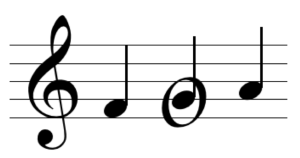 |
| Neighbor Tone (NT) | Step | Step | Opposite | Both upper and lower exist | 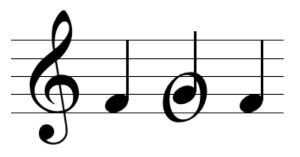 |
| Double Neighbor or Changing Tone (CT) | Step then Skip | Step | Varies | Chord tone to nonchord tone, to nonchord tone to chord tone |  |
| Appoggiatura (APP) | Leap | Step | Opposite | Appoggiatura is usually on a strong part of the beat |  |
| Escape Tone (ET) | Step | Leap | Opposite | Escape tone is usually on a weaker part of the beat | 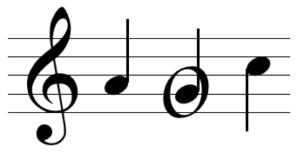 |
| Suspension (SUS) | Static note | Step | Down | Suspension is always on a stronger part of the beat | 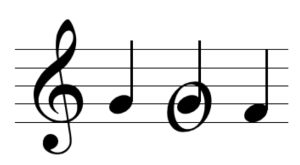 |
| Retardation (RET) | Static note | Step | Up | Retardation is always on a stronger part of the beat | 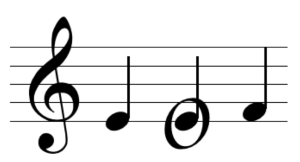 |
| Pedal Tone (PED) | Static note | Static note | N/A | Stays on the same pitch | 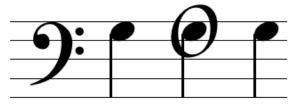 |
| Anticipation (ANT) | N/A | Static note | N/A | The anticipation is usually on a weaker part of the beat | 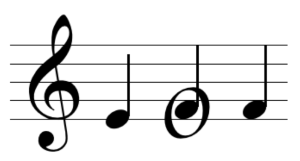 |
Example 11. Summary of embellishing tones.
- Embellishing tones (.pdf, .mscz). Asks students to write embellishing tones in a two-voice texture and label embellishing tones in an excerpt. Worksheet recording
References
This chapter is an adaptation of "Embellishing Tones" by John Peterson in Open Music Theory, vs. 2. Adaptations include:
- Adding a section on double neighbor tones.
- Adding the H5P activity "Desperately Seeking Nonharmonic Tones"
- Adding additional information on suspensions and retardations, including the section "Why are all the suspensions in the bass voice called 2-3 suspensions?"
- Amending the table summary of nonharmonic tones at the end of this chapter to include images of nonharmonic tones, which come from Victoria Malawey's chapter "Non-Chord Tones" from Multimodal Musicianship.
- Embedding the Nonharmonic Tones lesson from MusicTheory.net.
Resources
In addition to the sources cited above, the following resources were consulted in the adaptation of this chapter:
Benward, Bruce and Saker, Marilyn. (2021). Cadences and Nonharmonic Tones. Music in Theory and Practice, vol. 1.
Hutchinson, Robert. (2025). Non-Chord Tones. Music for the 21st Century Classroom.
Mount, A. (n.d.) Nonharmonic Tones. Fundamentals, Function and Form. University of Nebraska. Pressbooks.
Musictheory.net [https://www.musictheory.net]
Interactive Tutorial
All materials used in this chapter are licensed with the Creative Commons CC BY-NC-SA 4.0 International license.
Related to European or American culture.
A note value that lasts half the duration of a quarter note, or the duration of two sixteenth notes.
A type of rest that lasts half the duration of a quarter rest, or the duration of two sixteenth rests.
Key Takeaways
- Nonharmonic tones can be grouped into three categories (summarized in Example 13):
- Involving only stepwise motion: passing tone, neighbor tone
- Involving a leap: appoggiatura, escape tone
- Involving static notes: suspension, retardation, pedal, anticipation
Overview
One of the tools that composers use to make music more interesting is the nonharmonic tone. A nonharmonic tone is a pitch that is added to a composition that is not part of the surrounding chord. The nonharmonic tone creates dissonance which in turn creates momentary musical tension - a really cool effect. In this chapter you will learn about the various different kinds of nonharmonic tones and how they work, and begin to learn how to find them within their musical context.
How to Find a Nonharmonic Tone
One of the most challenging aspects of learning about nonharmonic tones is learning how to spot them. Once you have spotted the nonharmonic tone, it becomes much simpler to discern what type of nonharmonic tone it is, as the options are fairly limited. The tutorial embedded below, "Desperately Seeking Nonharmonic Tones" is designed to help you build this skill.
Passing tones, neighbor tones: Nonharmonic tones that move by step
Example 1 showed the two kinds of embellishing tones that move by step: passing tones (PTs) and neighbor tones (NTs). Passing tones are approached by step and left by step in the same direction, either ascending or descending (Example 3). Neighbor tones are approached by step and left by step in the opposite direction, producing either an upper neighbor or a lower neighbor (Example 4).
Example 3. Passing tones in a two-voice texture, (a) ascending and (b) descending.
Example 4. (a) Upper neighbor and (b) lower neighbor tones in a two-voice texture.
Appoggiaturas and escape tones: Embellishing tones that involve a leap
Examples 5 and 6 show the two kinds of embellishing tones that involve a leap: appoggiaturas (APPs) and escape tones (ETs). Appoggiaturas are approached by leap and left by step in the opposite direction (Example 7). The appoggiatura typically occurs on a stronger part of the beat than its surrounding notes. Escape tones are approached by step and left by leap in the opposite direction (Example 8). The escape tone typically occurs on a weaker part of the beat than its surrounding notes. It is more common for appoggiaturas and escape tones to be left by motion downward (Examples 7a and 8a) than upward (7b and 8b).
Example 5. An appoggiatura in Joseph Boulogne, String Quartet no. 4, I, mm. 5–9 (0:09-0:19).
Example 6. An escape tone in Margaret Casson, "The Cuckoo."
Example 7. Appoggiaturas in a two-voice texture.
Example 8. Escape tones in a two-voice texture.
Suspensions, anticipations, and pedal tones: Embellishing tones involving static notes
Examples 9–11 show three of the four kinds of embellishing tones that involve static notes (i.e., notes that don't move): suspensions (SUS), retardations (RET), and pedal tones (PED). A fourth kind of embellishing tone, the anticipation, deserves special comment below.
Suspensions are approached by a static note and left by step down, while retardations are approached by a static note and left by step up (Examples 9 and 10). Both suspensions and retardations are always on a stronger part of the beat than the surrounding notes. (Suspensions are discussed in greater detail in the chapter on fourth species counterpoint.)
Pedal tones are often found in the bass. They consist of a series of static notes below chord changes that do not include the bass. We typically label them using the scale degree number of the pedal note, as in Example 11.
Example 9. Suspensions and a retardation in Joseph Boulogne's String Quartet no. 4, I, mm. 47–49 (1:30–1:36).
Example 10. (a) Suspension and (b) retardation in a two-voice texture.
Example 11. Pedal tone in Josephine Lang's "Dem Königs-Sohn," mm. 16–18.
Like the suspension, retardation, and pedal tone, anticipations also involve static notes. But anticipations are a two-note (rather than three-note) gesture, in which a chord tone is heard early as a non-chord tone (Example 12). In other words, it “anticipates” its upcoming membership in a chord.
Example 12. An anticipation in Josephine Lang's "Erinnerung," mm. 29–30 (1:54–1:59).
Summary
The table in Example 13 provides a summary of the embellishing tones covered in this chapter.
[table “41” not found /]
Example 13. Summary of embellishing tones.
- Embellishing tones (.pdf, .mscz). Asks students to write embellishing tones in a two-voice texture and label embellishing tones in an excerpt. Worksheet recording
A physical and/or social setting.
The elliptical part of the note. Can be either filled in (black) or outlined (white).
Key Takeaways
- Historically (in the 17th and 18th centuries) musicians and composers use figured bass to imply harmonies in ensemble works. Figured bass refers to the bass voice, under which figures and other symbols indicate implied harmonies.
- Figured bass is not usually added to chord symbols; however, it is added to triadic shorthand notation.
- It is called realizing figured bass when musicians turn figured bass into chords, either on paper or in performance.
- Triads and seventh chords have figures which correspond to root position and inverted harmonies when realized. Full figures are often abbreviated.
- In order to denote chromatic alterations to notes, musicians put accidentals (♭, ♯, ♮) before the figure that is altered. Musicians also use slashes through a figure or a plus sign before a figure, in order to indicate raising the note by a half step.
- Orphaned accidentals (accidentals which do not appear alongside a number) apply to the third above the bass.
- Horizontal lines indicate a change of note above a given bass, or a change in harmony.
- Figures are sometimes paired with Roman numerals to provide more information to music analysts.
In the 17th and 18th centuries, paper and ink were somewhat expensive materials. To save money--and also time--composers and musicians sometimes implied harmonies in ensemble works, without writing them out fully. Figured bass refers to the the bass voice or part, under which figures and other symbols indicate to musicians the implied harmony.[1]
Triadic Figures
Figured bass uses Arabic numerals and some symbols which indicate intervals above the bass note, which are then interpreted as chords by musicians. Example 1 shows the full figured bass for triads, as well as chord symbols for the same harmonies:
Example 1. The full figured bass for triads, as well as chord symbols.
As you can see in Example 1, a root position triad has a third and a fifth above the bass (indicated by "[latex]\begin{smallmatrix}5\\3\end{smallmatrix}[/latex]"). A first inversion triad has a third and a sixth above the bass (indicated by "[latex]\begin{smallmatrix}6\\3\end{smallmatrix}[/latex]"), and a second inversion triad has a fourth and a sixth above the bass (indicated by "[latex]\begin{smallmatrix}6\\4\end{smallmatrix}[/latex]"). In figured bass, larger numbers always appear above smaller ones.
In order to save even more time (and more paper space!), composers and musicians abbreviated the full figured bass for triads and seventh chords. Example 2 shows the abbreviated figured bass for triads that we usually use today, as well as their chord symbols:
Example 2. The abbreviated figured bass for triads.
As you can see, no figure appears for root position. The superscript number "6" will result in a first inversion triad, while a second inversion triad keeps its full figures, "[latex]\begin{smallmatrix}6\\4\end{smallmatrix}[/latex]," to distinguish it from a first inversion triad.
Figured bass is not usually added to chord symbols; however, it is added to triadic shorthand notation. For example, the last measure of example 2 would be notated as "A/E" in chord symbols. Using triadic shorthand, this chord would be notated as "A[latex]\begin{smallmatrix}6\\4\end{smallmatrix}[/latex]."
When musicians turn figured bass into chords—either on paper or in performance—this is called realizing the figured bass. Example 3 shows the process of realization for several triads:
Example 3 Some triads with figured bass and their realizations.
As seen in the first measure of Example 3, an E♭ appears with no figured bass next to it. Therefore, we can assume that we are realizing an E♭ major triad in root position. This chord is realized (written out with notes) in the next measure. In measure 3, we see the figure "6" below the bass note G. We can understand that notation to mean that we are realizing a sixth and a third above the bass note G. This chord is realized in the next measure (an E♭ major triad in first inversion). In measure 5, we see the figures "[latex]\begin{smallmatrix}6\\4\end{smallmatrix}[/latex]" below the bass note B♭. This notation means that we are realizing a sixth and a fourth above the bass note B♭. This chord is realized in the next measure (an E♭ major triad in second inversion).
Seventh Chord Figures
Example 4 shows the full figured bass for seventh chords, as well as chord symbols for the same harmonies:
Example 4. The full figured bass for seventh chords, as well as chord symbols.
As you can see in the full figures of Example 4, a root position seventh chord has a third, fifth, and seventh above the bass. A first inversion seventh chord has a third, fifth, and sixth above the bass, while a second inversion seventh chord has a third, fourth, and sixth above the bass. Finally, a third inversion seventh chord has a second, fourth, and sixth above the bass.
Example 5 shows the abbreviated figured bass for seventh chords that musicians use today underneath their chord symbols:
Example 5. The abbreviated figures for seventh chords.
As seen in Example 5, a root position seventh chord is abbreviated with the superscript number "7" while the figures "[latex]^6_5[/latex]" will result in a first inversion seventh chord. A second inversion seventh chord is indicated by the figures "[latex]^4_3[/latex]" and the figures "[latex]^4_2[/latex]" will result in a third inversion seventh chord. Sometimes, in older style figured bass notation, a third inversion seventh chord is notated simply as a superscript "2."
You can realize figured bass for inverted seventh chords in a similar way to how you realized them for triads. To realize an inverted seventh chord, simply write the indicated intervals above the bass note, keeping in mind that the full figures are usually abbreviated. Example 6 shows the process of realization for several seventh chords:
Example 6. Some seventh chords with figured bass and their realizations.
As seen in the first measure of Example 6, an A appears with the superscript figure "7" under it. Therefore, we can assume that we are realizing an A dominant seventh chord in root position. This chord is realized (written out with notes) in the next measure. In measure 3, we see the figures "[latex]^6_5[/latex]" below the bass note C♯. We can understand that notation to mean that we are realizing a sixth, fifth, and third above the bass note C♯. This chord is realized in the next measure (resulting in an A dominant seventh chord in first inversion). In measure 5, we see the figures "[latex]^4_3[/latex]" below the bass note E. This notation means that we are realizing a sixth, fourth, and third above the bass note E. This chord is realized in the next measure (resulting in an A dominant seventh chord in second inversion). In measure 7, we see the figures "[latex]^4_2[/latex]" below the bass note G. This means that we are realizing a sixth, fourth, and second above the bass note G. This chord is realized in the next measure (resulting in an A dominant seventh chord in third inversion).
Other Figured Bass Symbols
In order to denote chromatic alterations to notes, musicians put accidentals (♭, ♯, ♮) before the figure that is altered. Example 7 shows a few realizations of figures with accidentals:
Example 7. Realizations of figures with accidentals.
So, for instance, in Example 7, the flat sign before the 6 indicates that the 6th above the bass note is lowered by a half step, changing the pitch from a B natural to a B♭, and the natural before the the 3 indicates that the 3rd above the bass note has been lowered by a half step, changing the pitch from an F# indicated by the key signature to an F natural.
Musicians also use slashes through a figure or a plus sign before a figure, in order to indicate raising the note by a half step. These symbols and their realizations are shown in Example 8:
Example 8. Realization of figures with a slash and a plus sign.
An orphaned accidental (or hanging accidental) is also common. These are accidentals that appear by themselves, and may or may not be accompanied by other figures or symbols. In these cases, the accidental is assumed to apply to the third above the bass, as seen in Example 9:
Example 9. Realization of orphaned accidentals.
There is one other symbol that is commonly seen in figured bass. Horizontal lines indicate a change of note above the given bass, or a change of harmony. Example 10 shows several realizations of figures with horizontal lines:
Example 10. Realization of figures with horizontal lines.
In the first measure of Example 10, the horizontal line indicates a change of note above the given bass. We could read this as "a fifth above the bass moves to a sixth above the bass," as realized in measure 2. Sometimes this indicates a suspension, which you can read more about in Embellishing Tones. You can see an example of a suspension in measures 3 and 4 above; this could be read as "a fourth above the bass moves to a third above the bass." Horizontal lines can also indicate a cadential [latex]^6_4[/latex] chord, which you can read more about in Strengthening Endings with Cadential 6/4. You can see an example of a cadential [latex]^6_4[/latex] in measures 5 and 6 above; this could be read as "a sixth above the bass moves to a fifth above the bass," and "a fourth above the bass moves to a third above the bass." As you can see in measures 5 and 6 of Example 10, more than one horizontal line can appear at the same time in figured bass. Horizontal lines can also indicate a change in harmony, as seen in measures 7 and 8 above; this could be read as "a chord with a sixth above the bass moves to a chord with a fifth above the bass," since it is the bass itself which is moving.
Roman Numerals and Figures
Roman numerals are often paired with figures to denote chord inversions and certain embellishments. For example, a superscript "6" figure could be paired with the Roman numeral "I" to represent a tonic triad in first inversion, and the figures "[latex]^4_3[/latex]" would indicate a second inversion dominant seventh chord when paired with the Roman numeral "V." However, not all instructors use figures with Roman numerals, so you'll only want to do this if your instructor has indicated that you should. Example 11 shows a few realized Roman numerals with figures:
Example 11. Realization of Roman numerals with figures.
In this class, figures will be used with Roman numerals as shown in Example 11.
The table below is a summary of the different types of symbols commonly used for figured bass.
| Complete figured bass symbol | [latex]^5_3[/latex] | [latex]^6_3[/latex] | [latex]^6_4[/latex] | 7
5 3 |
6
5 3 |
6
4 3 |
6
4 2 |
|---|---|---|---|---|---|---|---|
| Symbol most often used | none | 6 | [latex]^6_4[/latex] | 7 | [latex]^6_5[/latex] | [latex]^4_3[/latex] | [latex]^4_2[/latex] |
| Indicates | root position triad | first inversion triad | second inversion triad | root position seventh chord | first inversion seventh chord | second inversion seventh chord | third inversion seventh chord |
| Symbol | How it is used |
|---|---|
| ♭, ♯, ♮ | A sharp, flat or natural that is not alongside a number indicates that the third interval above the bass note should be sharped, flatted or naturaled. |
| 6 6 6
♭, ♯, ♮ |
A sharp, flat or natural below a 6 indicates a first inversion triad with the third above the bass sharped, flatted or naturaled. |
| ♭6, ♯6, ♮6 | A sharp, flat or natural on either side of a number indicates that that interval above the bass (in this example a "6") should be sharped, flatted or naturaled. |
| A slash on any number indicates that that interval above the bass should be raised a half step. Sometimes there will be a plus sign (+) instead of a slash. |
- Figured Bass Inversion Symbols (Robert Hutchinson)
- Figured Bass: How to Read Chord Inversion Symbols (LANDR)
- Figured Bass (thinking music.ca)
- Figured Bass Notation: Tutorial (Iowa State University)
- Figured Bass (Andre Mount)
- How to Realize a Figured Bass (Robert Kelley)
- Figured Bass Symbols (Robert Kelley)
- Realizing Figured Bass Chords, I (.pdf)
- Realizing Roman Numerals with Figured Bass (website), pp. 2, 5 (.pdf), p. 11 (.pdf)
- Writing Roman Numerals and Figures for Bass Lines with Figured Bass, II and VII (.pdf), pp. 1, 3, 4 (.pdf), p. 11 (.pdf)
- Triadic Figures (.pdf, .mcsz). Asks students to write chord symbols and identify the inversion of closed-position chords, and to realize chords from chord-symbol-and-figured-bass notation.
- Seventh Chord Figures (.pdf, .mcsz) Asks students to write chord symbols and identify the inversion of closed-position chords, and to realize chords from chord-symbol-and-figured-bass notation.
The materials in this chapter come from Open Music Theory, with the exception of the tables of figured bass symbols, added by Elizabeth Pauly.
Occurs when a potential cadence point is declined by the material that follows it. A common strategy is for a composer to write music that proposes a cadence, but then to "back up" in the phrase and try the cadence again. See also the "one-more-time" technique in the chapter on phrase expansion.
A tonic that is initially absent for the first sections of a song, but arrives later on (often in the chorus). Often tied to lyrical themes of attained triumph, self-confidence, or clarity.
